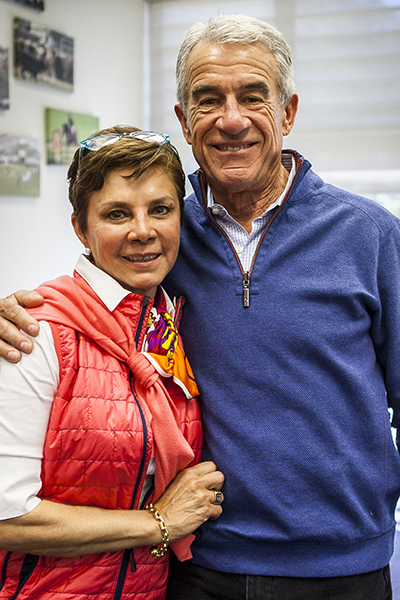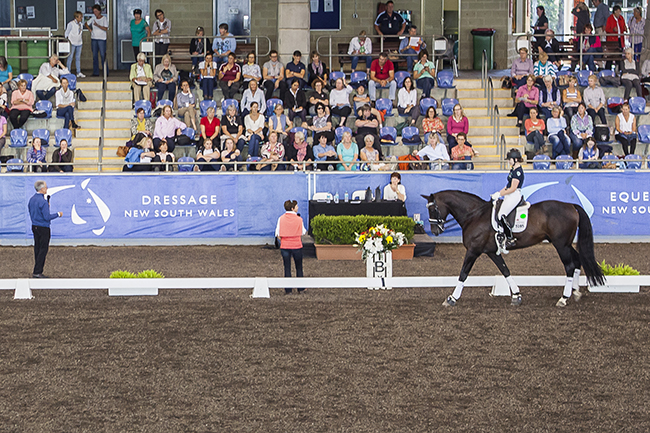 Rebecca Ashton reports and she took the photos…
Rebecca Ashton reports and she took the photos…
The post Sydney CDI Judges Clinic was a little short on horses this year with riders packing up and going home after a long competition week. “We lost some horses so we’ll do what we can do,” mused Gary Rockwell, one of the two international judges running the day. The American 5* judge was accompanied by Mexican Maribel Alonso-Quinzanos, who will be President of the Ground Jury in Rio.
The first horse out was SPH Renaissance (by Royal Hit out of PSI Octavia) with Rodney Martin. The little five year old mare has been super successful right through the young horse classes. Rodney brought her straight in from the stable so we were able to watch the warm up.
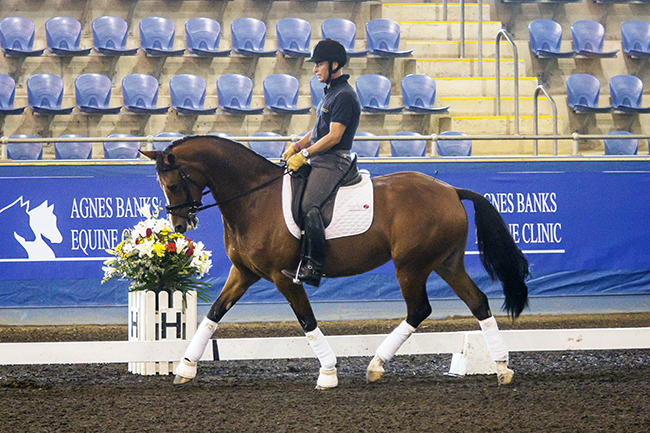 Rodney and SPH Renaissance
Rodney and SPH Renaissance
Gary commented, “My best three horses were mares so I’m quite partial to them. I always give them an extra point! What is difficult with the young horse classes is that the horses all progress at a different rate so I hope riders use their judgement. Four and five is quite rideable but I think the six year old is quite difficult. If the horse has been ridden by a great rider from the start without any problems then it could be alright, but we have amateur riders and sometimes the horses aren’t completely on the bit.”
This wasn’t an issue for Rodney and Fleur and it showed right from the start with smooth, flowing work. Gary continued, “She’s very flexible so there’s no need with this one to do so much. The warm up gets the hocks bending and gives the horses a reason to balance themselves. She’s very attentive to the rider and has a very efficient hindleg, a built-in energy that he doesn’t have to create.
“You have to understand that girls need to feel good. Sometimes you just go to the barn and do some rising trot and go home. There’s no point going on sometimes.”
“Like all women,” chimed in Maribel. “She’s very loose and very easy, willing to please and willing to work. She has good communication with the rider.”
Rodney continued to slowly put the horse together as Gary gave us a running commentary, “Now he’s taking up the reins. All horses have a stiff side and a bent side and it’s very important to address this in the warmup, to channel the energy with straightness. You don’t want the energy to be lost sideways, then there’s no need for the horse to pick up its legs.”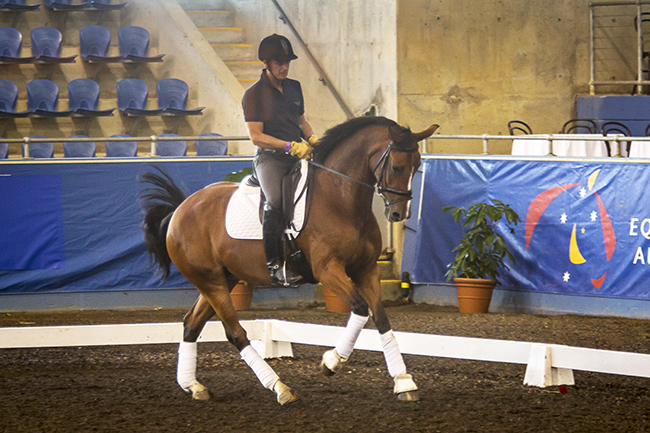
“Lots of transitions are good, then they start to listen for you. I like your approach here, Rodney. All three gaits are clear and of good quality. Our whole sport is based on lengthening and shortening. The rider’s leg activates the energy, and the seat and hand determines whether the forward motion is allowed, or whether she comes back. From there we move into lateral work to start stride control. Two track work is our major tool to develop power and balance. If we try to collect horses in straight lines we fight with the mouth. Working sideways, the control is not in the mouth, but in the leg.”
“Now she comes up into a nice balance. She has the beginnings of self-carriage and lightness of the forehand. She is forward thinking and we need that.”
Maribel was also impressed, “The contact and connection are so steady for a five-year-old. If we were judging her it would not be a problem to go high with the marks.”
Gary was keen to bring attention to Rodney’s good hands and suggested not everyone he had judged over the competition had been so diligent, “Make note of his hand position. We had a variety of hand positions this weekend! It should be elbow, hand, bit. It’s like you go to a golf lesson and you’re told to hold the club a certain way and you don’t change it. I don’t know why it’s different with horses. Another hand position would not work with her. Hand position is a red flag for a judge. Good hands will allow the energy of the horse to flow through, not have it hide between the hand.
Maribel agreed, “Hands can be very disturbing. You see it and it becomes the focus and you can’t see how the horse is performing any more!”
After a short Q&A, the pair performed movements from the test, focusing first on the shoulder in before looking at the medium trot. There wasn’t much to correct with this combination, just a little bit of adjusting in the shoulder in left. Gary helped out, “Bend her a little bit right first. A little lower on the right rein. Take her neck more out toward the wall. A little bit more angle but no more bend. Totally loose on the left and down on the right. This is a beautiful trot.”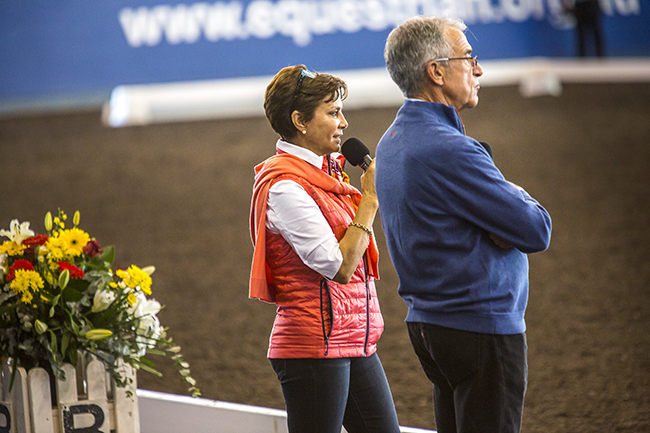
Gary explained the correct set up for the medium trot before highlighting where he saw a lot of marks lost over the competition, “Build it up, then start to release a little then squeeze really hard. I saw many points lost this weekend in canter extensions. They have to be ridden almost to the letter. If you start to make the transition back near the quarter line, you lose marks for the transition and the extension. Build up the energy in the corner. The first step should be a full extension. Then they see the wall coming up and they want to sit back a little off it so you have to encourage it.”
“Absolutely,” agreed Maribel, “Either they fade away and make a long transition toward the corner or they go all the way into the corner and do a flying change there.”
“And changes,” continued Gary, “All the sequences should be centred around X. I saw a more than average number of mistakes in the canter this weekend and I believe it was because they were not well set up.”
The overall marks for Rodney and Fleur? Walk: 9 Trot: 8 “It got better,” explained Gary, “I think for a 9 it would have to show more in the medium. I would be higher on the canter. 8.5/ 9. I like the canter best. She was a little fussy in some moments, but for the whole picture for a 5 year old, she’s an 8.”
However, I did wonder how they came to an overall of 8 and not 8.5. Is my maths bad?
Gordon Pratt and Bloomers Simply The Best were next to show us Medium.
The work began with developing the horse’s balance and shifting its weight a little more to the hindquarters. Gary explained his method, “Half pass is a major tool to develop power and balance. The forehand has to be in front of the hindquarters. If the quarters lead, the forehand will drop. The forehand needs a reason to lift a little. He has a nice swinging tail which indicates all is right with the world. This horse has a very nicely set on head and neck and a nice expression.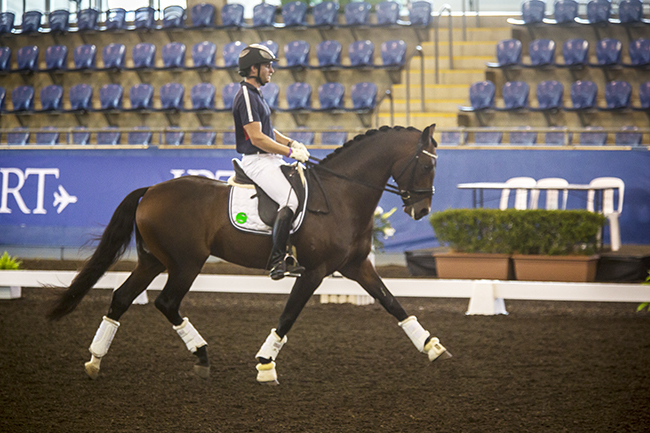
Gordon Pratt and Bloomers Simply The Best
“He’s just a little bit high in the head and neck, just keep him down an inch from the withers maybe just to let him through his back a little. Roundness on the outside rein. Yes, this is looser. My feeling is that this horse offers to come a little bit too high too early and he loses engagement. Right. Here is better.”
Maribel added, “We can see when he lowers his head and neck a little it gets better. The gait improves and it allows a better connection and use of his back.”
“The head and neck should come up when the whole forehand comes up. It’s about the amount of power that lifts the whole forehand. He is often a little bit too high for the power he is producing. But the horse has a good attitude I think,” enthused Gary.
Someone in the stands tactfully posed the question if Gordon was ever a show jumper. After a little chat to the rider, Gary grinned, “Ok, I’ll pick on his position. He’s given me permission. His neck is a little bit tilted forward. Generally your head will come up if you look further ahead. Also his hands were too flat. There are three possible hand positions. Straight, turn left and turn right. When the hand is flat, the hand is quite wide and it almost becomes an indirect rein aid. The thumb should be pointed straight forward or at the most toward the opposite ear and the fist closed like you’re punching someone. You have to have a rein on each side of the neck or else you do not have the horse on the bit. You need a direct rein on the outside of the horse, like a wall. It’s not about pushing the horse over with the rein.”
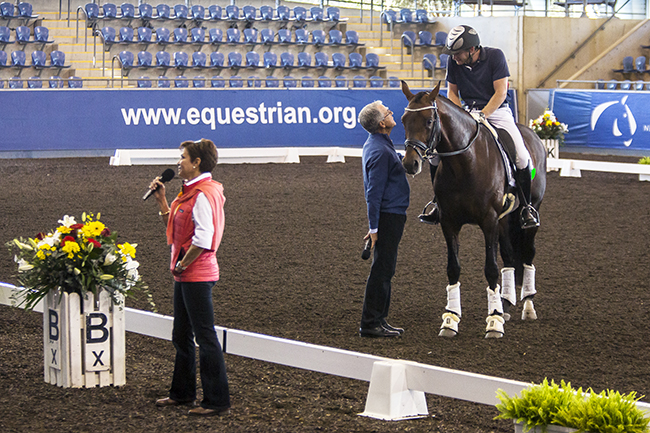
Gary asks Gordon if they can discuss his position
With rider position covered, it was onto the half passes and Gary was happy with what he saw, “I think this was pretty perfect. Really active with the hindquarters. You have to look at the letter you are going to every second or else you will lose your line or lose your bend. If the horse looks at the letter it’s correct. Have matching hand positions. Now can you make it shorter from H to X? Think more steps. The less sideways he goes the more he lifts the forehand. When horses show big steps sideways, then it’s not a collecting exercise.”
A little play with the medium trot took us to the end of the lesson. After the initial try, Gary wanted things a little tidier, “Can we start again? There’s too much happening at the beginning. Do a little less with your contact. Just let it flow from the corner. Don’t fix it. Find out how little you need to do with the hand. Trust him. Use the corner. Think of a lot of steps, not too big
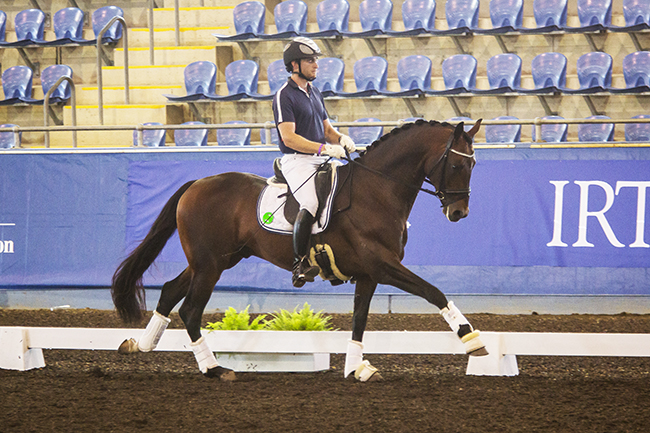
And then success, “Really well done. I think he has a lot of potential for the future. That was easily and Inter 1 transition. For a high score you need to have one medium canter the whole way.”
Mary Warren was generous enough to ride two horses in the clinic, the first being her Prix St Georges mount Mindarah Park Raphael. Gary and Maribel let the pair ride some movements first before correcting. Mary needed to work on closing the horse up a little more. Gary explained, “I would like you to ride the shoulder in again. He opens up his stride a bit too much. Ride more steps. He needs to take more up and down steps. Don’t think about pushing him to the left in shoulder in right.
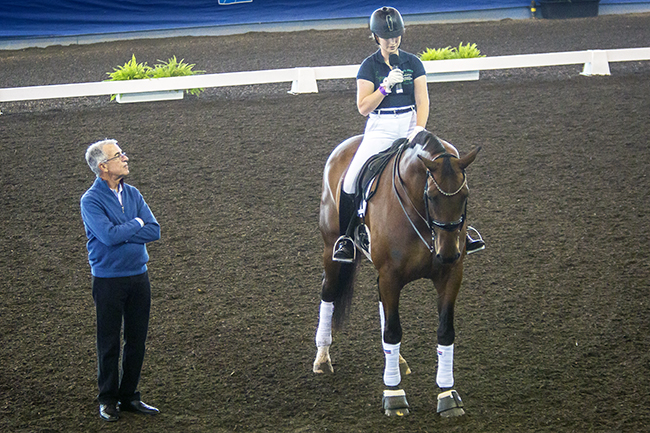
Mary Warren tells us about Mindarah Park Raphael
The message was similar in the half passes, “Don’t hurry the stride but ride more steps so he lifts the forehand. Try and get power without going forward. Relax your arms a little bit and think about controlling the first step. Little steps sideways. Yes, good.”
Gary addressed the audience, “It’s a well balanced horse. It’s a big horse. Horses of this type do long things more easily and take a little bit longer to collect. Mary sits very well. I think there’s a little bit of tension in the arms sometimes though so I’d like to see her relax her elbows a little more and lift him up form her leg rather than her hand a little more.”
Walk pirouettes were then marked and Gary had still more tips to improve the big horse’s balance, “I would give this a 5. You need to move the girth sideways, not the forehand so the forehand is leading a little bit. Soften the reins. Let him up a little. We need more small, little steps. Look up where you’re going. Keep it a little bigger. Keep the activity by walking with your seat so it stays quick and small. These are hard!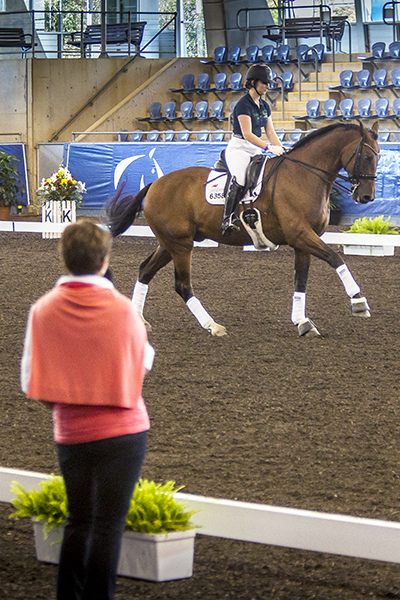
“Usually, your weight goes with your eyes. It’s a test to having them on the aids. What doesn’t work is having the poll too low. I think most riders come to the walk pirouette then change the pace. They change it with their body, the rider goes into rigour mortis and the horse thinks, ‘You want halt but we’re still moving so what do you want?’ When you come to the pirouette, nothing should change. It’s no different to any other movement. It’s something like half pass in the walk.”
Maribel chipped in, “Most of the riders also don’t put their inside shoulder back so the weight stays to the outside. You have to look where you’re going with your body, not just your eyes.”
Mary is a quick learner and produced the goods quickly to Gary’s pleasure, “Ok that was the best one. Now the mechanics are correct. I’d rather you bump him with the leg than lift with the hand because this cannot be maintained. Now the hocks are bending better now. It’s important that the poll stays the highest point as well.”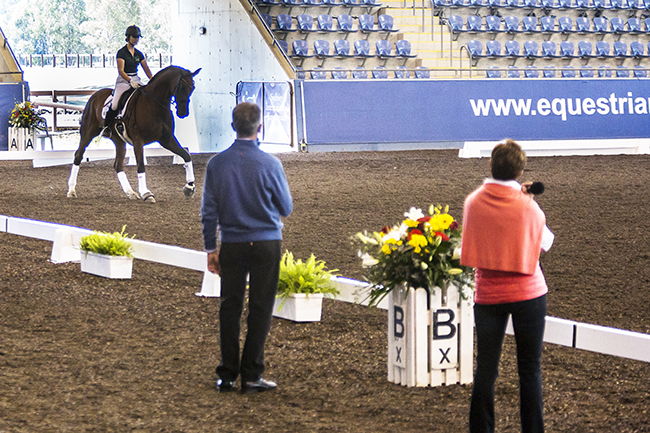
Satisfied, the American judge requested canter work, starting with half passes. Mary had to change her feeling at this pace as well to get the horse more closed and jumping, “Quicker than what feels comfortable for you. Make 100 steps!” encouraged Gary, “His natural gait is long and a little slow. That has to disappear from his repertoire. I would want to change is nature a little bit. Maybe carry a whip if he’s ok with that.”
Next were extended canters and Mary was encouraged to keep them short so to help the horse balance better and hence get stronger. However, Raphael kept changing canter leads so Gary asked Mary to be very careful with her balance and also check that her legs were remaining in the correct position. It was a good moment to bring up the idea of riders having a plan when things go wrong in the test. Gary explained, “There are 1000 things that can go wrong in a test that can happen at home. Make a plan. Riders often don’t have a plan. If a first level horse breaks from canter to trot, what’s the correction? A few steps (3-4) of balanced trot and then you start again. At the higher levels you walk and start again. Some riders throw their horse back in the canter and think that the judge didn’t see. We have seen it! We see horses in the ring that panic and we can tell they’ve had a big correction at home. Then they start getting tense and change whenever they get tense. Horses make mistakes all the time. It’s ok. Have a plan.
“When I saw horses coming to the pirouettes this weekend, I was scrambling for my seatbelt. It was like a seizure! In the Prix St Georges you have the whole way from K. That’s not the time to decide what colour you’re going to paint your house. You start working on balance and plan the movement.”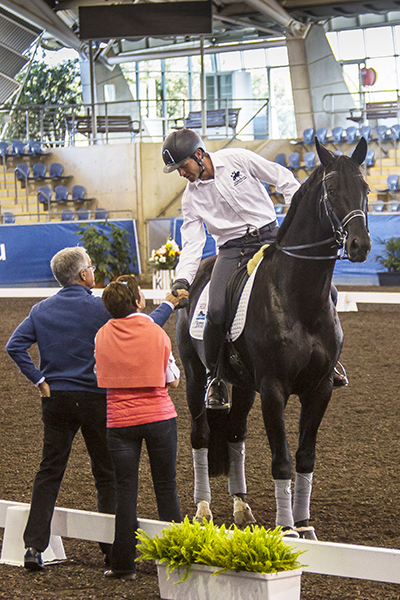
Gary and Maribel meet Deon Stokes and Don Dancier
That multi talented equestrian Deon Stokes was next on the rising nine year old Don Dancier. We had the pleasure of watching the pair’s winning Advanced freestyle with the judges’ comments afterwards.
Maribel began, “So, let’s look at the rhythm and paces. Gaits and Impulsion; do we have three good gaits? What was missing from the collection? Was he regular and clear? I’d give them a 7.5.” Gary continued, “For an 8, the pirouette needed to be a bit better. He came off his line a little bit before he started so then it’s 3/4 of a pirouette not a full one.”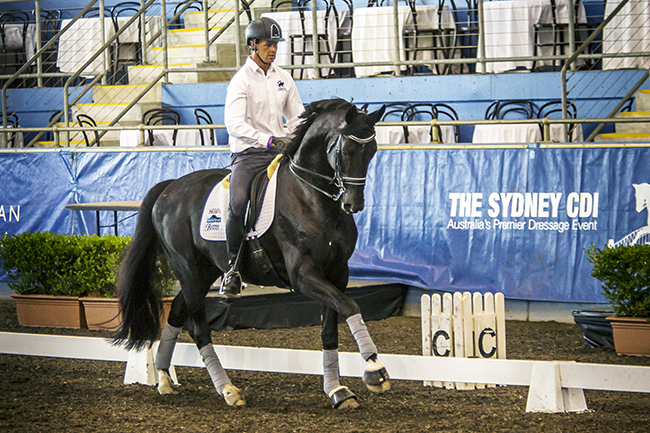
The next aspect was harmony and some of the judges in the audience were a little harsher than Gary, “Yes he hopped but recovered and made the flying changes so it’s not such a serious fault. I think it’s easy to remember the things that went wrong but I saw so many nice things. What about the quality of the changes? I saw a lot of 8s. There’s still 9 and 10 you know, so the little hop before the changes is not so important. The horse’s training is completely in the right direction.”
When choreography was discussed, Gary awarded a 7.5/8 and alluded that it could be a little more interesting. Deon wanted to discuss this further, “On that note, it’s really hard at this level to increase the degree of difficulty without it being Prix St Georges and you get a zero for that for being too hard.”
“Yes, you’re right,” was Gary’s reply, “But I think it’s your pirouette. Get them right and your degree of difficulty would go up. Also, there are things you can do with the changes and half passes. You could do your changes on the centreline. The horse finds everything easy.”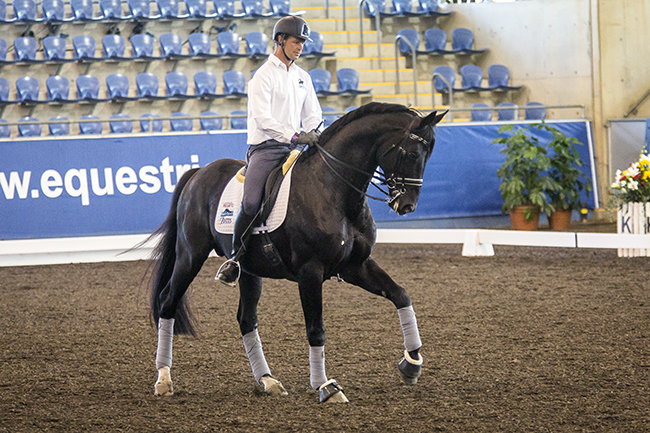
Deon and Don Dancier pirouette
It was time to look at certain aspects of the test and the pirouettes were the first to come under the microscope. The “Dreaded Walk Pirouettes” were first. Gary was really making a point today! “This is what we said before and we are seeing all the time. He changed his line and therefore it wasn’t a full pirouette. Hold him out on the line with your right leg before you start it then take him around (to the right). That’s 1-2 points higher because it started at the right place and he owned it. Again. Pick your tempo before. Somewhat small and quick so you don’t have to change it when you get to the turn. And the canter pirouette, I would say it’s the same as the walk pirouette. Keep him out on your line beforehand with the inside leg. Keep roundness with the outside rein. Usually the pirouette is made or lost in the first stride. Good. Collection. It’s getting a little open. You need some bending first. I won’t be convinced that your weight is on the inside if your eyes aren’t up and looking where you’re going to go. Good. He has good ability for it. Keep the revs up beforehand.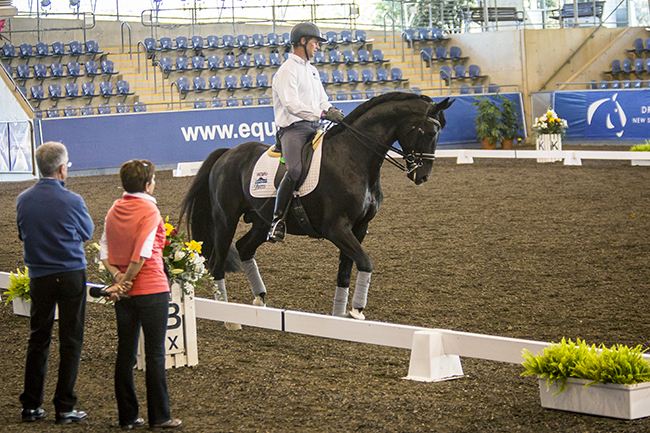
“How many strides in the pirouette? 3-4 in half and 6-8 in full. Last night we saw in the Grand Prix freestyle double pirouettes in 8 strides. Impossible!”
The pair finished on a positive note with the medium trot. That’s right and at the end, that’s the transition we were missing. If you don’t come back to the original canter, the test starts sliding away from you a bit.”
Maribel summed up the combination, “This horse will be a good horse for the sport in this country. I think this is going to go somewhere.
Mary Warren was back in the arena to round out the day on her Grand Prix mount Mindarah Park Ramadan, the 13 year old father of Raphael.
Mary began warming the big horse up but Gary was after a slightly different approach. “I think for a Grand Prix horse, this warmup is too sprawling. I don’t think he needs to warmup like a first level horse. Quicker, more together and forward and back. If you feel slowness, you don’t have to hit him with the whip but just touch in a quicker rhythm to which he offers. I fully believe in stretching horses but he has big, long strides and he likes it too much down there. Quicker with the tempo. Don’t go big canter. Don’t give up the quickness. It should feel a little bit uncomfortably quick for you.” Maribel agreed that both horse and rider needed to get out of their comfort zone.
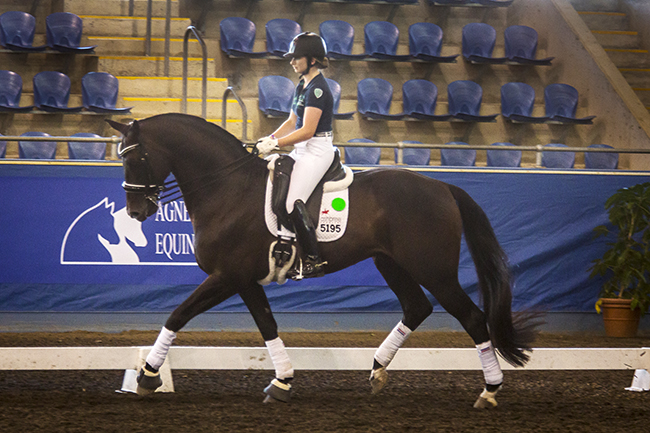
Mary Warren on Mindarah Park Ramadan
The transitions also needed to be more responsive so Gary offered up the exercise of canter from the rein back, “Transitions are important. If they are delayed and fluffy, you don’t get off to a good start. You’ve got to respond a little. When you canter off, you could cluck or karate scream if you want! It’s not allowed to feel like a sofa, Mary. Now pat him and be nice. Look up and ahead. Look up to the top of the stands. Touch him on the top of the croup a few times with the whip. Good. Now medium, just a few strides. And back. You have to work harder to bring him back, Mary. Forward is easy. Soft arms, relaxed elbows.”
It was straight into trot shoulder in and Gary continued his corrections of the pair, “Soften the reins and shoulder in left. Very good. More outside rein. He’s tilting a bit. Soften to the right then soften both reins. Loose on the left and down on the right. The only thing you can do when you see this tilting is to get rid of some of the bend to begin with. On the bit needs to be the most comfortable place to be.”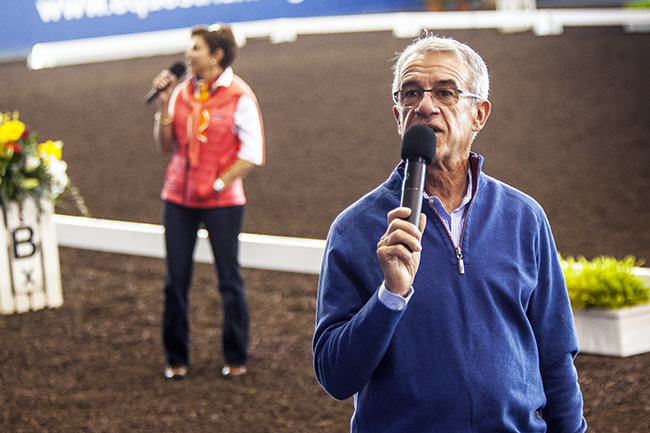
There was a look at the canter half passes and flying changes before putting them together for the zigzag. Again the requirements were the same; quicker steps and more jump so the big stallion didn’t shuffle and become earth bound. Gary walked down to C to watch, “If you look ahead you’re going to see the bend in front of you. Make it easier for him by softening your back. All flying changes have to be straight. One, straighten, straighten, change bend, two, straighten, straighten, change, bend. Again it comes down to him being hot to her aids. I think she feels like she needs to do more and that upsets his balance. In these movements, the horse needs to be responsive to small aids.”
Maribel added, “You have to show the correct bend and collection and the correct strides. Even one mistake means you have to go down.
The tempis also required Mary to have smaller aids despite Ramadan being a natural with the changes. Gary requested, “I would just say you want to end one stride before the letter, not four. Look high and soften the reins before the first stride. I think you’re bringing your legs much further back then you need to. Think more that you need to bring your inside leg forward more than your outside leg back.”
The session ended with piaffe and passage and Gary again explained the execution, “The aid for passage is exactly the same as the aid for trot. We saw some drivers today but pushing the seat doesn’t propel the horse forward. The upper body incites whether we want things long or short. Stretch the abdominals. Relax and hands forward if you want lengthening. The driving only achieves in pushing the horse down into the shoulder. As you ask for it, your upper body lifts, you use your core. Sit still and keep your weight constant. Just sit down. If you move up and down he won’t come up to your seat. It’s easier for him if you can be still. If he backs off, bump him with the leg but don’t encourage him every step. Keep your hands super low. Now he’s better through the back. Almost piaffe. Good!”
Maribel summed up the day as an attempt to, “…improve communication between riders, trainers and judges.” With lots of Q&A, spectators’ opinions and open discussion, I think the goal was achieved. Thank you to the combinations also who allowed an audience of judges to mull over their every move in the name of education.
